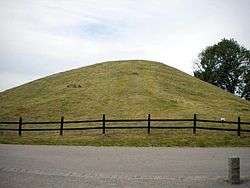Aun


Aun the Old (Aun inn gamli, latinized Auchun, English: "Edwin the Old") mythical Swedish king of the House of Yngling in the Heimskringla. Aun was the son of Jorund, and had ten sons, nine of which he was said to have sacrificed in order to prolong his own life. Based on the internal chronology of the House of Yngling, Aun would have died late in the 5th century.[1] He was succeeded by his son Egil Vendelcrow (Íslendingabók: Egill Vendilkráka) [2] identified with Ongentheow of the Beowulf narrative and placed in the early 6th century.
Ynglingatal
Ruling from his seat in Uppsala, Aun was reputedly a wise king who made sacrifices to the gods. However, he was not of a warlike disposition and preferred to live in peace. He was attacked and defeated by the Danish prince Halfdan. Aun fled to the Geats in Västergötland, where he stayed for 25 years until Halfdan died in his bed in Uppsala.
Upon Halfdan's death Aun returned to Uppsala. Aun was now 60 years old, and in an attempt to live longer he sacrificed his son to Odin, who had promised that this would mean he would live for another 60 years. After 25 years, Aun was attacked by Halfdan's cousin Ale the Strong. Aun lost several battles and had to flee a second time to Västergötland. Ale the Strong ruled in Uppsala for 25 years until he was killed by Starkad the old.
After Ale the Strong's death, Aun once again returned to Uppsala and once again sacrificed a son to Odin; this time Odin told the king that he would remain living as long as he sacrificed a son every ten years and that he had to name one of the Swedish provinces after the number of sons he sacrificed.
When Aun had sacrificed a son for the seventh time, he was so old that he could not walk but had to be carried on a chair. When he had sacrificed a son for the eighth time, he could no longer get out of his bed. When he had sacrificed his ninth son, he was so old that he had to feed, like a little child, by suckling on a horn.
After ten years he wanted to sacrifice his tenth and last son and name the province of Uppsala The Ten Lands. However, the Swedes refused to allow him to make this sacrifice and so he died. He was buried in a mound at Uppsala and succeeded by his last son Egil. From that day, dying in bed of old age was called Aun's sickness.
|
Historia Norwegiæ
The Historia Norwegiæ presents a Latin summary of Ynglingatal, older than Snorri's quotation (continuing after Jorund):
|
Iste genuit Auchun, qui longo vetustatis senio IX annis ante obitum suum densæ usum alimoniæ postponens lac tantum de cornu ut infans suxisse fertur. Auchun vero genuit Eigil cognomento Vendilcraco [...][7] |
He became the father of Aukun, who, in the feebleness of a protracted old age, during the nine years before his death is said to have abandoned the consumption of solid food and only sucked milk from a horn, like a babe-in-arms. Aukun's son was Egil Vendelkråke, [...][8] |
Notes
- ↑ based on the story of his supernaturally long life (close to 200 years), he would have lived during most of the 4th and 5th centuries; a tumulus identified as that of Ottar, a son of Aun who fell in battle, has been excavated and found to contain a coin of the 5th century. Barry Cunliffe, The Oxford Illustrated History of Prehistoric Europe (2001), p. 475.
- ↑ the Íslendingabók gives Aun as the successor of Jörundr and the predecessor of Egil Vendelcrow: xv Jörundr. xvi Aun inn gamli. xvii Egill Vendilkráka.Guðni Jónsson's edition of Íslendingabók
- ↑ Ynglinga saga at Norrøne Tekster og Kvad
- ↑ A second online presentation of Ynglingatal Archived September 28, 2006, at the Wayback Machine.
- ↑ Laing's translation at the Internet Sacred Text Archive
- ↑ Laing's translation at Northvegr Archived March 11, 2007, at the Wayback Machine.
- ↑ Storm, Gustav (editor) (1880). Monumenta historica Norwegiæ: Latinske kildeskrifter til Norges historie i middelalderen, Monumenta Historica Norwegiae (Kristiania: Brøgger), p. 100.
- ↑ Ekrem, Inger (editor), Lars Boje Mortensen (editor) and Peter Fisher (translator) (2003). Historia Norwegie. Museum Tusculanum Press. ISBN 87-7289-813-5, p. 77.
Primary sources
- Ynglingatal
- Ynglinga saga (part of the Heimskringla)
- Historia Norwegiae
Secondary sources
Nerman, B. Det svenska rikets uppkomst. Stockholm, 1925.
| Aun | ||
| Preceded by Jorund |
Mythological king of Sweden First reign |
Succeeded by Halfdan |
| Preceded by Halfdan |
Mythological king of Sweden Second reign |
Succeeded by Ale the Strong |
| Preceded by Ale the Strong |
Mythological king of Sweden Third reign |
Succeeded by Egil Ongenþeow |